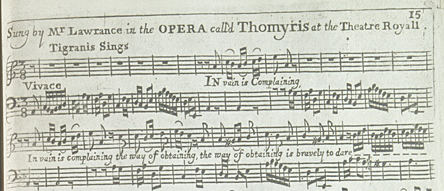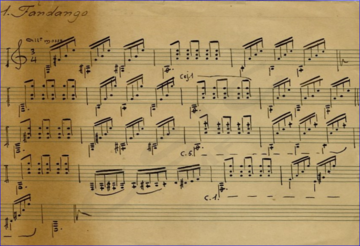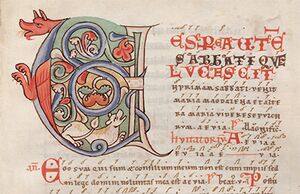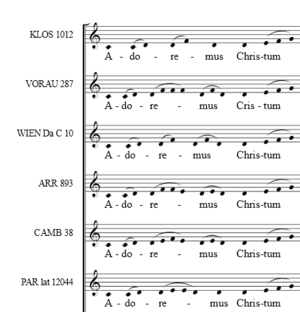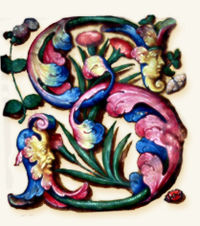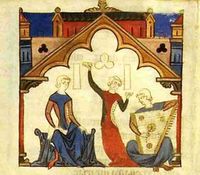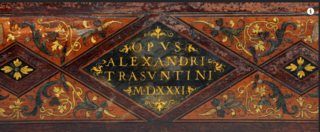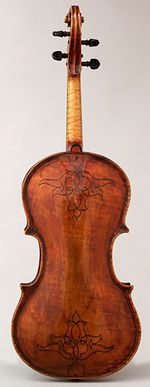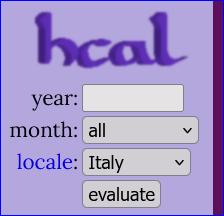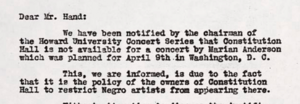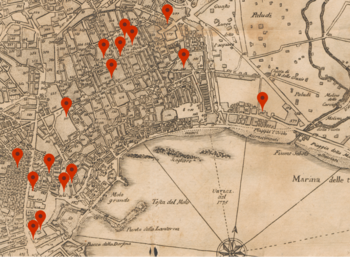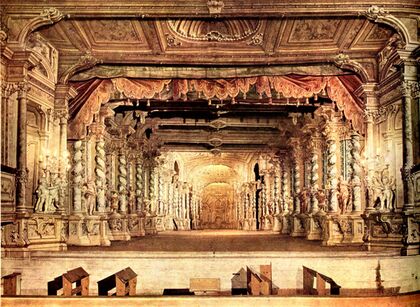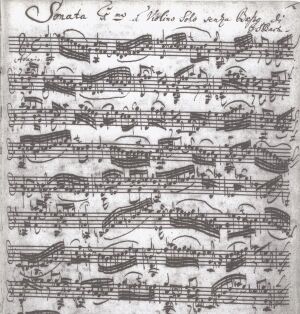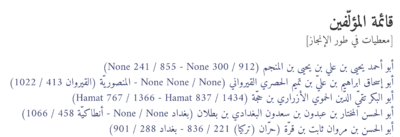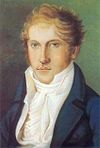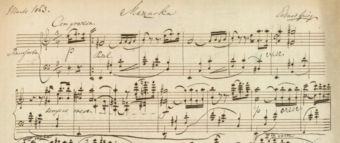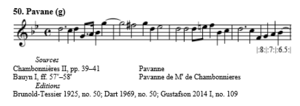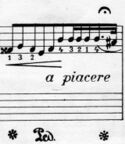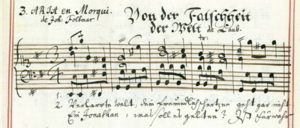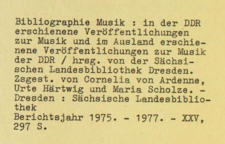Difference between revisions of "Template:DRM databases"
| Line 117: | Line 117: | ||
Website: http://www.cantusfractus.org | Website: http://www.cantusfractus.org | ||
| − | [[File:RomanGradual-1624.jpg|thumb| | + | [[File:RomanGradual-1624.jpg|thumb|350px|right|<small>Roman Gradual published in 1614. Trento, Castello di Bonconsiglio, [http://www.cantusfractus.org/raph_1/edizioni/FSG_19.html#descrizione_FSG19 Biblioteca Feininger, FSG 19]. This was the first volume (1614) in the Medicea [reformed] series edited by Felice Anerio and Francesco Suriano.</small>]] |
An abiding problem in chant research is the evaluation of rhythm and proportion. This website (in Italian) by Marco Gozzi explores interpretative methods for repertories that are viewable online in early prints and manuscripts. A [http://www.cantusfractus.org/raph_1/database.htm search form] facilitates the retrieval of examples by source location. Excellent leaf-by-leaf viewing tools are provided. | An abiding problem in chant research is the evaluation of rhythm and proportion. This website (in Italian) by Marco Gozzi explores interpretative methods for repertories that are viewable online in early prints and manuscripts. A [http://www.cantusfractus.org/raph_1/database.htm search form] facilitates the retrieval of examples by source location. Excellent leaf-by-leaf viewing tools are provided. | ||
Revision as of 22:33, 26 March 2024
Most databases currently used are focused on a single subject. The methods by which they are structured is widely varied. Sites in which the material is predominantly textual are listed below. Text and image are integrated on some sites. Sites that focus on images with only sparse metadata are listed above. Among subjects listed here here: catalogues, inventories, and thematic indices; letters and treatises; instrument makers; ethnomusicological sources; and image archives.
Contents
- 1 Secular Vocal and Folksong Repertories
- 2 Bodleian Library Broadside Ballads Catalogue
- 3 Books of Hispanic Polyphony (BHP)
- 4 César: French Theatrical Database
- 5 Catalogue de la Chanson Française à la Renaissance (Chanson Database)
- 6 CLORI: Archive of the Italian Cantata
- 7 Deutsches Volksliedarchiv (German Folksong Archive)
- 8 Early American Sacred Music
- 9 EASMUS: Early American Secular Music and its European Sources
- 10 English Broadside Ballad Archive
- 11 HUAPALA: Hawaiian Lyrics and Hula Archives
- 12 Loire Valley Chanson Sources
- 13 Old English Songs
- 14 Fondo de Música Tradicional (Traditional Music of Spain)
- 15 VolksLiedWerke (Austrian Folksong Database)
- 16 Sacred and Liturgical Music
- 17 Antiphonale Synopticum
- 18 CANTUS Manuscript Database: A Database for Latin Ecclesiastical Chant
- 19 Cantus Fractus Database (Projetto Raphael)
- 20 Cantus Planus Austria
- 21 Cantus Planus Regensburg
- 22 Cantus Ultimus
- 23 ChantDigger
- 24 Comparatio (Chant Comparison)
- 25 Corpus Pulcriorem Invenire (CPI-I): Online catalogue of Conductus poetry and musical settings
- 26 Differentiae Database
- 27 Digital Analysis of Chant Transmission (DACT)
- 28 Fontes Cantus Bohemiae
- 29 Gregorien
- 30 Hungarian Chant Database
- 31 Hymn Tune Index
- 32 Mass Database (Mainz)
- 33 Mass, Office, and Holy Week Music Printed in Italy (1518-1770)
- 34 Medieval Music Manuscripts, Austria
- 35 Medieval Music Database (MMD)
- 36 Motet Database (1475-1600)
- 37 Motets printed in France (Motet imprimé en France 1647-1789)
- 38 Musica Sacra
- 39 Musicat
- 40 Plainchant Sources in Poland (Cantus Planus in Polonia)
- 41 Portuguese Early Music (PEM) Database
- 42 Printed Sacred Music Database
- 43 Psalm Database (Psalmendatenbank)
- 44 RELICS (Renaissance Liturgical Imprints)
- 45 Slovak Early Music Database (Cantus Planus in Slovakia)
- 46 Spanish Early Music Manuscripts (Musica Hispanica)
- 47 Instrumental Music
- 48 The Clarinet Quintet
- 49 Classical String Quartets
- 50 Hof-Musik (Court Music)
- 51 Jazzomat Research Project (Weimar Jazz Database)
- 52 Instrument Makers and Collections
- 53 Boalch-Mould Online: A research database of harpsichords and clavichords, 1440–1925
- 54 Liuteria Bresciana: Brescian Instrument Makers
- 55 MINIM-UK
- 56 Music Instrument Museums Online (MIMO)
- 57 National Music Museum
- 58 The Piano in Polish Collections
- 59 Polish Folk Instruments
- 60 Historical and Liturgical Calendars
- 61 Historical Calendars of Europe (HCAL)
- 62 Liturgical Calendars
- 63 Performers and Musical Personnel
- 64 Marian Anderson: Diaries and Notebooks
- 65 Musico Napolitano (Neapolitan Musician)
- 66 Other Rubrics
- 67 British Music Festivals Repertoire (1695-1940)
- 68 European Theatre Architecture (EUTA)
- 69 Germania Sacra
- 70 Medici Archive Project
- 71 Reid Concerts
- 72 Composer/Theorist Documentation
- 73 Bach Digital
- 74 Max Bruch Archive
- 75 Irving Berlin Collection (Library of Congress)
- 76 Arrigo Boito Papers (Archivio Boito Digitale)
- 77 Aaron Copland Collection (Library of Congress)
- 78 Fux Online
- 79 Handel Reference Database
- 80 Lassus Manuscript Database
- 81 Mozart Correspondence
- 82 Mozart Family: Letters and Documents (1755-1879)
- 83 In Mozart's Words
- 84 Mozart: New Documents
- 85 Ricordi Historical Archives: Verdi Correspondence and Memorabilia
- 86 Saramusic (Arabic manuscripts and texts on music)
- 87 Schenker Documents Online
- 88 Franz Schubert Online
- 89 Ludwig Senfl Online
- 90 Louis Spohr Correspondence
- 91 Giuseppe Verdi Correspondence (Braidense Library)
- 92 Digitized Manuscripts and Early Printed Music
- 93 Danish National Digital Sheet Music Archive
- 94 Darmstadt University and State Library Digital Manuscript Collection
- 95 Early Music Online
- 96 National Library of Scotland
- 97 Singakademie Music Archives
- 98 Online Thematic Catalogues and Indices
- 99 The Bizet Catalogue
- 100 Benjamin Britten Thematic Catalogue
- 101 Chambonnières: A Thematic Catalogue
- 102 Frescobaldi Thematic Catalogue Online
- 103 GWV - Graupner-Werke-Verzeichnis (Thematic Catalogue of the Works of Christoph Graupner)
- 104 J.P.E. Hartmann Catalogue (Thematic-Bibliographic Catalogue of His Works)
- 105 Franz Liszt: Digital Liszt Sources and Works Catalog)
- 106 Catalogue of Carl Nielsen's Works
- 107 Johann Adolph Scheibe: A Catalogue of his Works
- 108 Printed music resources
- 109 Prices of Music at Breitkopf & Härtel
- 110 Verzeichnis deutscher Musikfrühdrucke / Catalogue of early German printed music
- 111 Ethnomusicology
- 112 OSMIKON
- 113 Philippine Indigenous Instrument Sounds (Katunog)
- 114 UNC Middle Eastern Music
- 115 Tunisian Recordings (CMAM)
- 116 Resources for Chronology
- 117 Music Bibliography in the German Democratic Republic
- 118 Hofmeister XIX
- 119 Libretto Portals
- 120 Corago Project
- 121 Corniani-Algarotti Libretto Collection
- 122 Russian Opera Libretti
- 123 Albert Schatz Collection (Library of Congress)
- 124 VifaMusik Libretto Portal
- 125 Index to Opera and Ballet Sources Online
Secular Vocal and Folksong Repertories
Bodleian Library Broadside Ballads Catalogue
Website: http://www.bodley.ox.ac.uk/ballads/project.htm
The Bodleian broadside ballads project, which was developed mainly from 1995 to 2000, spans the history of the genre. A search form enables users to access the allegro Catalogue of Ballads by sheet or ballad title, first line, and tune name as well as publisher, date, and other parameters.
Books of Hispanic Polyphony (BHP)
Website: https://hispanicpolyphony.eu
Books of Hispanic Polyphony IMF-CSIC (BHP), hosted in Barcelona by the Institució Milà i Fontanals of the Spanish National Research Council (IMF-CSIC), serves as a comprehensive research tool concerning manuscript and printed polyphony books in Spain and books elsewhere containing Hispanic polyphony. Its initial coverage is for the 15th-20th centuries, but it had no chronological imitations. BHP does not provide images of the sources, unless holding institutions provide them. In these cases BHP incorporates the appropriate links (e.g. to the Biblioteca Digital Hispánica, covering books at the Biblioteca Nacional de España in Madrid). BHP also incorporates links to descriptions of manuscripts in DIAMM, the Digital Image Archive of Medieval Music, to prints listed in Printed Sacred Music Database 1500-1800, to the Portuguese Early Music (PEM) database, and to other appropriate websites that could offer relevant information.
The main menu for “Sources” (1509 items), “Locations”, “Institutions” (392), “People” (1036), “Genres”, “Works” (4696), “Movements” (4750), “Documents” (96) and “Bibliography” (1034) gives a sense of the breadth of BHP; additional materials are continually being incorporated by the project’s team, directed by Emilio Ros-Fábregas; the webmaster is Jan Koláček.
César: French Theatrical Database
Website: https://cesar.huma-num.fr/cesar2
The Calendrier électronique des spectacles sour l'ancien régime et sous la révolution is a searchable database of personnel (broadly defined), titles, dates, venues, and pertinent treatises on the French theater of the seventeenth and eighteenth centuries. Among its most unusual holdings are its calendar of police reports from the revolutionary period. With over 400,000 items covering actors, playrights, venues, et al., CESAR covers the entire francophone world. This project was originated jointly at Oxford Brookes University by Barry Russell (1943-2003) and in Toronto by David Trott (1940-2005). It is now hosted at the l’Université Grenoble Alpes. A companion image bank currently draws on ten institutional collections.
Catalogue de la Chanson Française à la Renaissance (Chanson Database)
Website: http://ricercar.cesr.univ-tours.fr/3-programmes/basechanson
A search site with extensive metadata and musical incipits for a repertory of 10,000 works from the sixteenth century. Multiple settings of the same text have individual listings (e.g. "Susanne un jour" currently has 26 listings). Works can be searched by title, scoring, composer, source, location, and text. Instrumental arrangements of originally texted pieces are included. The site is cross-referenced to comprehensive secondary sources and modern editions. The project is directed by Annie Cœurdevey at Ricercar, the musicology research program of the Centre d'Études Supérieures de la Renaissance (CESR) at l'université François-Rabelais de Tours.
CLORI: Archive of the Italian Cantata
Website: http://www.cantataitaliana.it
CLORI, which hosts cantata texts, manuscript source citations, and images that show characteristics of handwriting, has a number of sponsors and collaborators including the Italian Musicological Society (SIdM in Italian), the University of Rome (Tor Vergata), the Italian Institute for Music History (IISM), and RISM. The project is headed by Teresa M. Gialdroni. Click the "ricerca" button to go to the search form.
Deutsches Volksliedarchiv (German Folksong Archive)
Website: http://www.dva.uni-freiburg.de/Deutsches_Volksliedarchiv
The German Folk Music Archive (in German) has evolved over a century (to 2014) as a central clearing house for folk songs from German-speaking lands. It contains several component parts including (1) a Lieder Lexicon in which folksong texts are listed alphabetically; (2) a listing of specific projects, mainly those with a critical dimension; and (3) a popular Song Lexicon.
Early American Sacred Music
Website: https://earlyamericansacredmusic.org
The focus of Early American Sacred Music is on choral music with sacred texts hand-copied or printed in America up to 1821. The European tradition is emphasized. Most of the sources are from New England. More than 300 secondary sources are represented. A number of historical archives and special collections within university archives are included.
EASMUS: Early American Secular Music and its European Sources
Website: http://www.colonialdancing.org/Easmes/Index.htm
This extensive canvas of secular music in the American colonies and early states (1589–1839) consists of a series of indices (titles, first lines, musical incipits [by scale degree], stressed notes, et al.). It was developed over the 1970s and 80s by Kate Van Winkle Keller, Robert Keller, Carolyn Rabson, Raoul F. Camus, and Susan Cifaldi. The contents include ballad operas, band music, song sheets, theater works, and the names of tunes played by musical clocks.
English Broadside Ballad Archive
Website: http://ebba.english.ucsb.edu
Six thousand English broadside ballads, mainly from the seventeenth century, are included in this comprehensive project extending to related artistic and cultural phenomena. It development continues through 2016.
HUAPALA: Hawaiian Lyrics and Hula Archives
Website: http://www.huapala.org
Under development since 1997, HUAPALA is a website consisting mainly of texts derived from recordings of Hawaiian traditional music. Its aim is to preserve the musical culture of the Hawaiian Islands through not only the lyrics but also associated artifacts. Some musical overlaps with Samoa and Tahiti allow for comparison of lyrics from the broader Polynesian world.
Loire Valley Chanson Sources
Website: http://www.goldbergstiftung.de/forum/index_de.php?a=forum&f=39
The Goldberg Foundation has set up a system of hyperlinks to digitized resources for this subsector of the chanson repertory. As a collaborative project, it is somewhat uneven in its offerings. In compensation, comments can be appended to listings.
Old English Songs
Website: http://athena.uky.edu/oes/intro.htm
This collection, housed at the University of Kentucky, was once owned by the double-bass player Domenico Dragonetti. The contents mainly consist of opera arias (Handel, Bononcini, Purcell) and cantatas (rather than folksongs or sea shanties) in scanned images.
Fondo de Música Tradicional (Traditional Music of Spain)
Website: http://musicatradicional.eu
The Fondo de Música Tradicional, hosted by the Institució Milá i Fontanals (IMF-CSIC) in Barcelona, includes more than 20,000 melodic transcriptions collected between 1944 and 1960 from regional oral traditions throughout Spain. Most music in the database [most in hand transcriptions, with a diatonic numerical encoding of the incipit] was compiled through efforts of the former Instituto Español de Musicología of CSIC. The website/database contains 10,000 unique pieces from more than 4,500 informants at 3,000 locations within Andalusia, the Balearic Islands, Castile-La Mancha, Castile and León Region, Catalonia, Extremadura, Galicia, Murcia Region and the Valencian community. The collection also includes old video and audio recordings. Additional materials are continually being incorporated by the project's team, directed by Emilio Ros-Fábregas. Independent musicians are invited to contribute their own materials.
VolksLiedWerke (Austrian Folksong Database)
Website: http://www.volksmusikdatenbank.at
The VolksLiedWerke is assembled from collections originating in Austria's states. Searches by title, personal name, or corporate name are possible. Supported by the Austrian National Library (Oesterreichische Nationalbibliothek) and other entities. Some regions have separate websites, such as this one for the Tyrol, where scores and recordings may also be found. Interface available in five languages.
Sacred and Liturgical Music
Antiphonale Synopticum
Website: http://gregorianik.uni-regensburg.de
The Antiphonale Synopticum project (currently in German only) is the most recent addition to the Cantus Index Network–a series of connected, online projects employing the same structure and methodology. Based at the Universität Regensburg, it is directed by Harald Buchinger. It seeks to support identification of textual and melodic variants. Antiphonale Synopticum and its networked partners operate under the guidelines of the Cantus Planus Study Group of the International Musicological Society, which include the free and open exchange of data in electronic form.
CANTUS Manuscript Database: A Database for Latin Ecclesiastical Chant
Website: http://cantus.uwaterlook.ca
Cantus is a large, steadily-growing resource containing inventories of medieval chant manuscripts and related analytical tools. Its original home was the Catholic University of America (Washington, DC) under Ruth Steiner. After a period at the University of Western Ontario (London) under Terence Bailey, the database was moved to the University of Waterloo where Debra Lacoste is the current project manager and Jan Koláček (Prague) is its web developer. It has recently expanded from inventories of antiphoners and breviaries to manuscript sources containing Mass chants, including sequences. By providing a searchable database of detailed information for (currently) over 160 medieval manuscripts and over 440,00 chants, the Cantus Manuscript Database is a useful digital archive for musicologists and other academic researchers, librarians, archivists, as well as performers of this early music. Users can search for chants by text, saints’ name or liturgical occasion, and Cantus ID number. Tools for browsing, analysis, and data-entry are provided. An introduction to the database can be found in a YouTube video by Lacoste (2014). The Cantus Manuscript Database is the flagship site in the Cantus Index Network–a series of connected, online projects employing the same structure and methodology. The Cantus Manuscript Database, Cantus Index, and its networked partners operate under the guidelines of the Cantus Planus Study Group of the International Musicological Society, which include the free and open exchange of data in electronic form.
Cantus Fractus Database (Projetto Raphael)
Website: http://www.cantusfractus.org
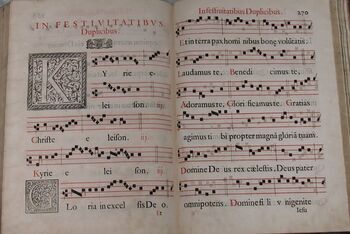
An abiding problem in chant research is the evaluation of rhythm and proportion. This website (in Italian) by Marco Gozzi explores interpretative methods for repertories that are viewable online in early prints and manuscripts. A search form facilitates the retrieval of examples by source location. Excellent leaf-by-leaf viewing tools are provided.
Cantus Planus Austria
Website: https://cantusplanus.at
Cantus Planus Austria is a significant constellation of resources including many digitized manuscripts of medieval chant, choir books, databases, and other materials related to church music of earlier times. Many of the sources are preserved in the Austrian National Library.
Cantus Planus Regensburg
Website: http://www-musikwissenschaft.uni-r.de/cantus
Cantus Planus Regensburg is a long-established web archive for medieval chant research. It includes downloadable data files and various databases, e.g. Post-Easter and Pentecost Alleluias, Responsories of the Dead (Ottosen), Advent Responsories (Hesbert), Medieval liturgical manuscripts in German and British libraries, and other pertinent tools such as David Hiley’s (et al) very useful medieval chant bibliographies. The project is directed by David Hiley and Robert Klugseder.
Cantus Ultimus
Website: https://cantus.simssa.ca/manuscripts/
Cantus Ultimus is a database of manuscript sources of digitized chants. Sources and their contents have been signaled by a network of chant researchers in Canada, the U.S., the U.K., and Europe. The database supports text searches by title, mode, feast, liturgical function, and folio number with each source.
ChantDigger
Website: http://www.oralhistoryofchant.ch/index.php/en/guided-tour
(Not currently maintained). The online implementation of Max Haas's lengthy investigation of chant variants is recent. After loading the data one can search either by text or by melody. A "canvas" offers a graph to map chant movement.
Comparatio (Chant Comparison)
Website: http://comparatio.irht.cnrs.fr
Comparatio, a member of the Cantus Index Network, presents transcriptions of selected chants in side-by-side views to facilitate the identification of liturgical traditions. It was developed at the Institut de recerche et d'histoire des textes (IRHT) of the Centre national de la recerche scientifique (CNRS) by Claire Maître. Comparatio and its networked partners operate under the guidelines of the Cantus Planus Study Group of the International Musicological Society, which include the free and open exchange of data in electronic form.
Corpus Pulcriorem Invenire (CPI-I): Online catalogue of Conductus poetry and musical settings
Website: http://catalogue.conductus.ac.uk
Mark Everist's CPI-I (Cantus pulcriorem invenire) contains almost 900 works found in 550 sources. The emphasis is on the poetry. A variety of ways to search it (by form, numbers of stanzas, lines per stanza, language, poet, and stanza rhyme structure) is available. Musical features (composer, notation, format) are also searchable. Sources listed are digitized and viewable online. Cross-listed to DIAMM and RISM.
Differentiae Database
Website: https://differentiaedatabase.ca
This searchable database is a component part of the CANTUS-related project Digital Analysis of Chant Transmission (see below).
Digital Analysis of Chant Transmission (DACT)
Website: http://dact-chant.ca
DACT presents itself as a repository for crowd-sourced fragments of liturgical chant. Many chant books were cannibalized in recent centuries to create Re-assmebling a complete book is a challenge. DACT offers an invitation to anyone possessing a leaf from a chant book to submit it to its fragment survey. The managers are eager to discover routes of transmission and geographical spread of such fragments. See also the entry on Fragmentarium under Digitized Music Manuscripts.
Fontes Cantus Bohemiae
Website: http://cantusbohemiae.cz
Fontes Cantus Bohemiae is a member of the Cantus Index Network–a series of connected, online projects employing the same structure and methodology. This site aims to inventory chant sources in Czech regions of Central Europe. Data representing 7,200 chants from the 12th-14th centuries have been uploaded to date in CANTUS-compatible formats.
FCB and its networked partners operate under the guidelines of the Cantus Planus Study Group of the International Musicological Society, which include the free and open exchange of data in electronic form.
Gregorien
Website: http://gregorien.info/en
Under the Répertoire tab of the Académie de Chant grégorien, the website Gregorien.info contains thousands of chant texts, their sources, and translations. The site is linked to the Cantus Index Network, and is now owned and directed by Inga Behrendt. The history of the development of the website is here. Gregorien.info and its networked partners operate under the guidelines of the Cantus Planus Study Group of the International Musicological Society, which includes the free and open exchange of data in electronic form.
Hungarian Chant Database
Website: http://gradualia.eu
The Hungarian Chant Database is a member of the Cantus Index Network–a series of connected, online projects employing the same structure and methodology. The Hungarian Chant Database stems from the earlier CAO-ECE (Corpus Antiphonalium Officii - Ecclesiarum Centralis Europae) work, which was designed to inventory and compare medieval Central European Office repertories. The component parts are these:
(1) CAO-ECE, the original component, was intended to facilitate studies of change in liturgical traditions over time and the study of other relationships within the liturgical Office of the middle ages.
(2) Gradualia, the newer component, brought similar capabilities to the medieval Mass but with greater attention to source material.
The HCD and its networked partners operate under the guidelines of the Cantus Planus Study Group of the International Musicological Society, which include the free and open exchange of data in electronic form.
Hymn Tune Index
Website: http://http://hymntune.library.uiuc.edu
The venerable Hymn Tune Index (HTI) has been developed over more than 40 years by Nicholas Temperley. Its initial aim was provide an index of all hymns with English-lnaguage lyrics up to the year 1900. At present the online part goes through 1820. Listing for the remainder of the nineteenth century are in progress. A full history is available here.
Hymn tunes have their own conventions of indexing, among which the metrical scansion of the verse(s) is prominent. Identical profiles are grouped together, facilitating a search by this rubric. Hymns can be search by name and by its HTI number; by title; by lyrics; by the name of a compiler; and by composer.
Temperley's work has produced the four-volume printed Hymn Tune Index published by Oxford University Press (1998); revisions to it can be found here. The online search capabilities have been developed at the University of Illinois since then.
Mass Database (Mainz)
Website: http://www.mdb.uni-mainz.de
Records for c.40,000 settings of the Ordinary of the Mass from 1400 to the present day. In process of migration (March 2014).
Mass, Office, and Holy Week Music Printed in Italy (1518-1770)
Website: http://sscm-jscm.org/instrumenta/instrumenta-volumes/instrumenta-volume-2
This online catologue by Jeffrey Kurtzman and Anne Schnoebelen in the Journal of Seventeenth-Century Music (JSCM) Instrumenta series contains 2,004 listings of printed music for the Mass and Office. The resource provides complete verbal material (title pages, dedications, prefaces, indices, contents by text incipits, liturgical and performance rubrics, and all other verbal material with the exception of full texts), most in diplomatic transcription, of all known prints of this repertoire. The remarks include format, sources consulted and other information of particular note. Entries, in pdf format, are fully searchable with lengthy indices of less obvious terms in all orthographical variants.
Medieval Music Manuscripts, Austria
Website: http://cantusplanus.at
The CantusPlanus.at website (officially entitled Musikalische Quellen des Mittelalters, or Musical Sources of the Middle Ages in the Austrian National Library), based at the Austrian Academy of Science, provides both detailed information on medieval music manuscripts in the Austrian National Library and basic information for manuscripts in all other Austrian libraries. Images for all manuscripts of the National Library plus full digitizations of some other special manuscripts (14,500 images) are provided. There is also access to the (manually-compiled) database of Constantin Schneider (1928), which addresses more than 1,650 sources. Several other data resources are included. Although not officially connected to the Cantus Index Network or Cantus Manuscript Database, several codices have been inventoried according to “Cantus” standards. The project leader is Robert Klugseder.
Medieval Music Database (MMD)
Website: http://www.lib.latrobe.edu.au/MMDB

The original database, a model of integrated presentation combined with independent search of text and music fields, was developed by John Stinson and John Griffiths at LaTrobe University (Australia) between 1987 and 1999, when the university's music department was closed. It was maintained over the next five years by the University Library and is still accessible (2014) at the above link. Plans to bring it under the umbrella of DIAMM are under discussion.
One of MMD's great strength, for students of liturgy, is the ability to scroll bilaterally through the temporal and sanctoral cycles, that is by feasts of the Ordinary and those of the Proper. Other supported search fields are text, composer, genre, manuscript, and melody. MMD is cross-referenced to the CAO database.
The musical examples in MMD were originally produced with Scribe software, also developed by Stinson and Griffiths (c. 1990). It encoded neumes and ligatures (mainly for fourteenth-century music) for printing on a color deskjet printer. It was designed for the DOS operating system and could export to the SCORE music-notation program. Jason Stoessel is continuing the development of the MMD.
Motet Database (1475-1600)
Website: http://www.arts.ufl.edu/motet/default.asp
Jennifer Thomas's guide to motets and Mass Propers in manuscript and printed sources from the period 1475-1600. 33,000 items, indexed section by section. Excludes Magnificats, Lamentations, canticles, and strophic hymns. Offers extensive scribal and source detail.
Motets printed in France (Motet imprimé en France 1647-1789)
Website: http://neuma.huma-num.fr/scorelib/corpus
This project within the NEUMA consortium currently contains a musical index with incipits (available in several formats) for almost 1,000 printed works. Notable composers represented in Campra, Couperin, Clérambault, and the Dutch polymath Constantijn Huygens together with motets by many little-known composers and several anonymous Noëls. Nathalie Berton-Blivet is the curator.
Musica Sacra
Website: http://musicasacra.com
This notable collection of scanned chant books includes the Liber Usualis and many other resources for modern use in traditional settings.
Musicat
Website: http://musicat.unam.mx/v2013/index.html
This website of the Seminario de Musica en la Nueva Espana y el Mexico Independiente, an international workgroup based in Mexico City, is a portal to two online, open-access databases of interest to musicologists, as well as an open-access digitized collection of 17th- and 18th-century music manuscripts from Mexico City Cathedral presented through agreement with the Universidad Nacional Autonoma de Mexico. These databases are in progress and growing:
- Musicat: Actas de Cabildo is a searchable compendium of references to music in cathedral documents in the period 1525-1828.
- Musicat: Catalogos de Musica is an OPAC catalog with musical incipits of manuscript and printed music at Mexican Cathedrals.
- Coleccion Estrada is a digitized collection of 122 manuscripts of 17th- and 18th- century Mexican music sources.
- Libros de coro is an online guide to the collection of choir books at Mexico City Cathedral. At present it includes 18,000 images.
Most pages contain explanations in both Spanish and English. The search page (in Spanish only) is found at http://musicat.unam.mx/nuevo/adabi_busqueda.php. Although works are predominantly sacred ones, many villancicos, pedagogical materials, and simple songs can also be found. Underlying literary sources are in Spanish, Latin, and African dialects found in sources. Tjhe databases are maintained by the Instituto de Investigaciones Esteticas of the Universidad Nacional de Mexico.
Plainchant Sources in Poland (Cantus Planus in Polonia)
Website: http://cantus.edu.pl
This member of the Cantus Index Network provides access to both Mass and Office sources in a range of libraries in Poland. It is based at the Polish Academy of Sciences in collaboration with other institutions and is directed by Bartosz Izbicki. Within Poland it is cross-linked with several music-bibliography sites. Cantus Planus in Polonia and its networked partners operate under the guidelines of the Cantus Planus Study Group of the International Musicological Society, which include the free and open exchange of data in electronic form.
Portuguese Early Music (PEM) Database
Website: http://pemdatabase.eu/compositions
The Portuguese Early Music Database (PEM) links Portuguese music manuscript listings with both RISM entries and the Cantus Manuscript Database (and its main catalogue, the Cantus Index). PEM is searchable by genre, feast, and composer. The digital holdings of the Centro de Estudios de Sociologia e Estética Musical consist overwhelmingly of short sacred vocal works found sources that are extremely fragile and therefore well served by digitization. Manuscripts are mainly from the 14th–16th centuries. All sources are reproduced in color. A full listing is here. PEM also maintains a list of links for early sacred-music projects. PEM and its networked partners operate under the guidelines of the Cantus Planus Study Group of the International Musicological Society, which include the free and open exchange of data in electronic form.
Printed Sacred Music Database
Website: http://www.printed-sacred-music.org/pages/indexes
This collection of metadata and musical incipits (1500-1800) has been developed over decades under the direction of David Bryant at the Fondazione Giorgio Cini Onlus, Venice, with significant contributions by many individual scholars, and is now served at the Institute of Musicology, University of Fribourg (CH) and implemented by the Swiss RISM office. Search by composers, publishers, musical incipits, and much else. The musical incipits are encoded in DARMS and are rendered in mensural notation. A series of catalogues is listed here.
Psalm Database (Psalmendatenbank)
Website: http://www.psalmmusic-database.de/index.php
The Psalmendatenbank has been developed in the Weimar-Jena musicology seminar under the direction of Helen Geyer. Contributors include Christian G. Grote, Michael Pauser, and Birgit Johanna Wertenson. Its focus is on psalm settings in Italian manuscripts of the seventeenth and eighteenth centuries.
RELICS (Renaissance Liturgical Imprints)
Website: http://quod.lib.umich.edu/r/relics
This database, hosted at the University of Michigan, contains entries on c. 14,000 sources of liturgical music printed through the year 1600. Started by David Crawford (1995) and continued by James Borders, the database contains entries from publications in France, Germany, and many other European countries. Coverage extends to multiple Roman Catholic rites and to Protestant and Jewish liturgies.
Slovak Early Music Database (Cantus Planus in Slovakia)
Website: http://cantus.sk
The Slovak Early Music Database is a member of the Cantus Index Network—a series of connected, online projects employing the same structure and methodology. The SEMD focuses on manuscript sources (some of them fragmentary) and some early prints from the eleventh to the sixteenth centuries. Based at the Slovak Academy of Sciences, it is directed by Eva Veselovská. The database, on which other Slovak institutions collaborate, currently offers over 300 items (manuscripts or fragments) which can be searched by title, feast, and other rubrics. Source images are available at high resolution. The Slovak Early Music Database and its networked partners operate under the guidelines of the Cantus Planus Study Group of the International Musicological Society, which include the free and open exchange of data in electronic form.
Spanish Early Music Manuscripts (Musica Hispanica)
Website: http://musicahispanica.eu
Spanish Early Music Manuscripts is a member of the Cantus Index Network–a series of connected, online projects employing the same structure and methodology. SEMM focuses on manuscript sources from medieval Spain, and endeavours to catalogue the “old Hispanic” chants in surviving antiphoners, breviaries, graduals and missals. Carmen Julia Gutiérrez is its project manager. SEMM and its networked partners operate under the guidelines of the Cantus Planus Study Group of the International Musicological Society, which include the free and open exchange of data in electronic form.
Instrumental Music
The Clarinet Quintet
Website: http://clarinetquintet.web.unc.edu
This online catalog is a continuing project to bring together all repertoire that exists for the clarinet quintet (defined as a string quartet plus a clarinet). The project seeks to offer complete, authoritative data relative to each composition and to demonstrate the totality of the genre. To that end, the site allows for, and welcomes, comments, verifiable corrections, and appropriate ancillary information that may help illuminate a better understanding of an individual work or the entirety of the repertoire.
This online catalog evolved from the personal catalog of Donald L. Oehler. Currently containing 600 works, it was developed over decades of a professional career. The project will continue to grow as works are regularly entered not only from Oehler's collected catalog listings but from the most recent and reliable data available for new works or newly discovered works. Currently (2015) the online catalog is approaching 400 entries." Each entry shows a facsimile of the first page and gives title concordances and other information about the work. The site's search boxes enables random access. Works can be grouped by period, country of origin, and key.
Classical String Quartets
Website: http://library.duke.edu/digitalcollections/quartets
This website may not represent the largest collection of this repertory, but it is the largest collection of digitized prints currently accessible online. Its contents are characterized as "rare and unusual" rather than mainstream. If you are looking for variety, consider Förster, Gassmann, Pixis, or Wranitsky (a small sampling of composers represented).
Hof-Musik (Court Music)
Website: http://www.hof-musik.de
Hof-Musik is not so much one database as a collection of resources for studying music and musicians (mainly instrumentalists) in the courts of Southwest Germany. It is based at the Heidelberg Academy of Sciences. Musicians are listed here, instrument makers [their metyhod here]. The number of smaller courts included is considerable. Some editions and facsimiles are also available.
Jazzomat Research Project (Weimar Jazz Database)
Website: http://jazzomat.hfm-weimar.de/index.html
Version 2.0 of the Weimar Jazz Database contains 456 transcriptions of solos by famous artists--John Coltrane, Dizzy Gillespie, Benny Goodman, Louis Armstrong, and many others. Hosted at the Hochschule für Musik Franz Liszt Weimar and headed by Klaus Frieler, it offers a Python Library (MeloSpyLib) for analytical purposes. In the database section, PDF scores give transcriptions for the solos. The search-tool Dig that Lick allows users to search the data for specific melodic patterns. The a statistical Feature History of Jazz facilitates feature mapping and scattering with user-selected constraints. JazzTube, developed at Erlangen University's AudioLabs, overlays YouTube videos with piano-roll notation of solos.
Instrument Makers and Collections
Boalch-Mould Online: A research database of harpsichords and clavichords, 1440–1925
Website: https://www.boalch.org
The designers of this website have given much thought to matters of organization. Early keyboard instruments were not mass-produced, and the range of differences from one to the next has been given due consideration. BMO is also unusual in accepting additions from private owners, which over time can produce a rounder picture of individual maker's achievements. The introductory video lays out the aims and organization of the material. Each instrument is assigned a BMO number to facilitate accurate citation. Among the useful details is a column giving the full range of the pitches produced (e.g. FF-f3 for the Hans Ruckers instrument in the Brussels Museum entered as BMO 111, dated c1612). This barely scratches the surface of the detail on offer, for one can quickly find many other precise specifications (e.g. dimensions, unusual features, previous owners) and in many cases photographs.
Liuteria Bresciana: Brescian Instrument Makers
Website: http://www.liuteriabresciana.it/pit001.htm
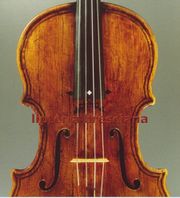
(Currently unavailable) Brescia was the first home of violin-making. So many of the early makers died in the plague of 1630-31 that Brescia was unable to regain its former glory. It exerted considerable influence on instrument-making in nearby Cremona, which flourished after 1650. Ugo Ravasio's former website (Liuteria Bresciana) covered the period from 1550 into until the mid-eighteenth century. His integration of archival documents, pictures of instruments, and a searchable database filled an important hole in our knowledge of the development of bowed string instruments. The great plague of 1630-1631 halved the Brescian population and nearly destroyed the instrument trade. The revival of this website is warmly anticipated.
MINIM-UK
Website: http://minim.ac.uk
MINIM is a composite online website (Musical Instrument Interface for Museums and Collections) for information, photographs and pertinent recordings of instruments in UK and Irish collections. With 20,000 listings, it is the largest repository of its kind in the UK and is managed by the Royal College of Music, London. Its central contributions come from the Royal College of Music, Edinburgh University, the Royal Academy of Music, and the Horniman Museum. Users may browse by collection or by instrument family. They may search by instrument name. Vivid illustrations are plentiful. MINIM is loosely linked with them pan-European MIMO project.
Music Instrument Museums Online (MIMO)
Website: http://www.mimo-international.com/MIMO
Music Instrument Museums Online (MIMO) is a multilingual, searchable site providing descriptions of individual musical instruments in curated collections worldwide. Its 55,000 items can be viewed by family or by location. Results can be filtered by date, place of production, and maker. Measurements and other details of each instrument are provided. Its iconographical value is very considerable. The spinet of 1610 by Vincenzo di Prato, pictured here, comes from Grassi collection in the museum of the University of Leipzig. MIMO's search engine adds new competencies by the week and currently supports more than a dozen languages including Chinese, Korean, and Basque (Euskara) as well as European languages and English.
National Music Museum
Website: http://orgs.usd.edu/nmm
The National Music Museum (Vermilion, South Dakota, US) possesses a highly diverse collection of instruments. It also houses a program on instrument conservation. The main components of the collections are (1) the Witten-Rawlins collection of Northern Italian (Brescian-Cremonese) strings from the seventeenth century, (2) an extensive group of instruments manufactured in the US in the nineteenth and twentieth centuries, and (3) a substantial collection of instruments from other parts of the world. The NMM provides links to many other little-known collections.
The Piano in Polish Collections
Website: http://www.piano.instruments.edu.pl/en/piano-makers
This website contains databases (with copious photographs) of historic collections, instruments, and ephemera in several Polish collections including the Museum of Industrial History in Opatowic, the Andrzej Szwalbe Collection in Ostromecko, and the Fryderyk Chopin Institutein Warsaw. Many of the photographs in the blog contain sketches, pastels, lithographs, and paintings of musicians at work.
Polish Folk Instruments
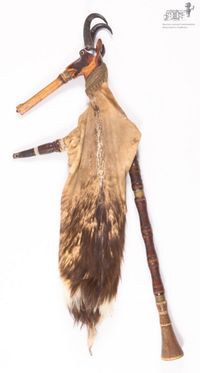
Website: http://instrumenty.edu.pl/en
The Museum of Folk Instruments in Szydłowiec, established in 1968, houses the largest collection of folk instruments in Poland and documents rich musical relationships with adjacent regions. Holdings date from the seventeenth century onward and currently number more than 2,000. The collection (which is housed in the Szydłowiecy-Radziwill Castle, is particularly rich in bowed instruments, cymbals, and bagpipes. Some links within the site provide sound files.
Historical and Liturgical Calendars
Historical Calendars of Europe (HCAL)
Website: http://hcal.ccarh.org
Those looking to reconcile modern dates with those in use before the Gregorian calendar was adopted can derive a correct translation here. Many more calendars were in use than those indicated here. Adoption of the Gregorian (modern Western) calendar occurred between 1582 and 1926. Standardized tools to generate early calendars (e.g. the Unix cal tool) ignore historical change and thus render incorrect results for some locales and periods of time.
Liturgical Calendars
Many sights offer these modern calendars with various degrees of refinement, but they are not appropriate for historical use. There can be local variations in the days of minor saints. See such sites as Liturgy Office (UK); the Liturgical Calendar Online; Greek Orthodox. Some cultures maintain separate civic and religious calendars and thus impose an additional level of complexity to the reconciliation of dates. Orthodox Jewish culture offers one example. In simpler circumstances, the Etz Hayim website offers instructive examples on the reconciliation of Christian and Jewish dating systems. The Muslim calendar is complicated in a global context because of its dependence on (the time of) the initial visibility of a new moon, in combination of adherents across many times zones. Additional cultures and religions, including Buddhism and Eastern Orthodoxy, are included in Santa Clara University's Calendars of the World's Religions website.
Performers and Musical Personnel
Marian Anderson: Diaries and Notebooks
Website: https://fromthepage.com/upenn/diaries-and-notebooks-of-marian-anderson
The digitization of Marian Anderson's diaries and notebooks awaits crowd-sourced transcription to make its content fully searchable. It is an enticing and extensive collection that captures an important chapter of American social as well as musical history. Anderson (1897-1993) spent most of her life in Philadelphia, and the preservation of this collection (more than 2,500 items) at the University of Pennsylvania suits it well. Performers' tussles with racial barriers paralleled those of sports figures in the middle decades of the twentieth century. The letter excerpted here documents a turning point both in Anderson's career and in what became a milestone in the Civil Rights Movements: having been prevented from appearing in Constitution Hall on Easter (April 9) in 1939, she sang on the steps of the Lincoln Memorial for a crowd of 75,000.
Musico Napolitano (Neapolitan Musician)
Website: http://musiconapolitano.unifr.ch
Musico Napolitano is a searchable database of references to musicians from Naples cited in letters, archival records, institutions, and other documentation. Based at the University of Fribourg, Switzerland, it has the aim of fleshing out bibliographies of migratory musicians whose biographies are not easily traceable. The website offers several rubrics to search by. These include rosters organized by name, role (or instrument), and institution. The map identifying the location of institutions is very useful. The website welcomes contributions of information.
Other Rubrics
British Music Festivals Repertoire (1695-1940)
Website: http://musicalfestivals.org
The Musical Festivals Database (MFD) provides a searchable database of repertory programmed in British festivals between 1695 and 1940. Many items come from the choral festivals that were popular in Britain in the eighteenth and nineteenth centuries. Results can quickly attest to the fickleness of taste, as specific locales, composers, and genres blinked on an off for brief periods.
European Theatre Architecture (EUTA)
Website: https://www.theatre-architecture.eu
Europe abounds in historical theaters, many associated with individual composers and repertories. This extensively illustrated resource combines historical detail with carefully composer photographs not only from the front stage view but also behind the scenes. It is presented in twelve languages with a button from automatic translation. Its centerpiece is the castle theater of Czesky-Krumlov (shown), which was begun in the 1660s, has been periodically closed, and once again offers Baroque opera.
Germania Sacra
Website: http://personendatenbank.germania-sacra.de/index/browse
Germania Sacra has several facets to what is essentially a database of personnel in German churches and monasteries from the medieval through early modern periods. Primary emphasis is placed on earlier period. The register of people (linked here) gives the flavor of the whole. It contains 4,000 listings (2016).
Medici Archive Project
Website: http://www.medici.org
The Medici Archive Project (MAP) is an ambitious effort to focus attention on the vast archives of the Medici Principiate (which endured from the early Renaissance until 1737) in the Florentine State Archives. It is conceived as a continuing project and has spawned several quasi-independent enterprises. The online database provides short transcriptions from across the entire documentary base. The project has thus far produced more than 300,000 digitized images of records from the Medici court. Its current activities emphasize lectures and the production of videos on specific topics related to the three centuries of rule by the family.
Reid Concerts
Website: http://www.reidconcerts.music.ed.ac.uk/content/home
This database of concerts (from 1841) itemizes musical programs given at many venues in the city of Edinburgh under the auspices of the the Reid School of Music in the University of Edinburgh. By itmeizing the contents of many of all preserved concert programmes, it attempts to chart the development and evolution of the ‘Reid Concerts’. Users may investigate composer, medium, genre, venue, date, or even professor in charge to cull specific profiles. The data collection overall enables the study of changes of taste and pedagogy as well as the constellation of pieces that make up concert programs. Begun in 2013, 'Reid Concerts' is still under development. (The School of Music is now a department within Edinburgh College of Art.)
Composer/Theorist Documentation
Bach Digital
Website: http://www.bachdigital.de/content/index.xml?lang=en
Bach Digital, based in Leipzig, is a one-stop shop for a catalogue of work by J.S. Bach (BWV); of scanned manuscripts; and of a database of manuscripts associated with the Bach family. When complete, it is intended to serve a wide variety of needs of scholars and interests of a wider music audience. An earlier Datenbank der Bach-Quellen (Database of Bach Sources) operates under the auspices of Göttingen's Johann-Sebastian-Bach Institute here.
Max Bruch Archive
Website: https://musikwissenschaft.phil-fak.uni-koeln.de/index.php?id=13144
This online archive documenting the life of Max Bruch (1838-1020) contains letters (c5000 of them), compositions, and other relevant materials. It was assembled at the University of Cologne between 2012 and 2021.
Irving Berlin Collection (Library of Congress)
Website: https://www.loc.gov/item/2012562128
This collection abounds in the artifacts of Berlin's long life (1895-1990). From scrapbooks of press clippings to account books for the Music Box Theater and family letters to copyright assignments we see the composer of "White Christmas" and "There's No Business like Show Business" in a constant swirl of activity. Most full scores, vocal scores, and sketches were transcribed by secretaries. Berlins' lyrics come from his own hand. For copyright reasons most items are unavailable until 2039.
Arrigo Boito Papers (Archivio Boito Digitale)
Website: https://opac.sbn.it
Arrigo Boito (1842-1918) was a composer but also a poet, novelist, and journalist who sometimes wrote under a pseudonym. His is best known today for his librettos for Verdi's Otello and Falstaff plus other stage works of the time. The circuitous route to a coherent archive of the composer's drafts and life began with the celebration of the centenary of his death in 2018. The variety and complexity of material may be typical of the musical giants of the later nineteenth century. A noted element of his biography was his long affair with the noted actress Eleonora Duse (1887-1894). Boito also served for eight years (1889-1897) as director of the Parma Conservatory.
What is unusual about this project is the coordination of materials in diverse physical locations to create a virtual archives through the SBN (Italian National Library) catalog.
Aaron Copland Collection (Library of Congress)
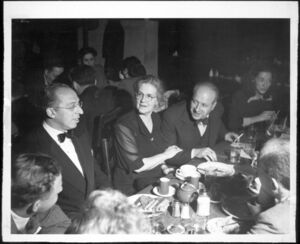
Website: https://www.loc.gov/collections/aaron-copland
The heterogeneity of this collection (782 items) represents the full array of Copland's life and activities. We go from photographs with his schoolmates in a Brooklyn second grade to retreats with distinguished colleagues in the late years of his life. Copland's essay of film music, prepared for a talk at Columbia University in 1940, which was based on his year of employment in Hollywood, offers a glimpse of the rapid pace of change in response to growing popularity of the medium.
Fux Online
Website: http://www.fux-online.at/cms_seite.php?content=0&menu=1
Fux Online is a growing compendium of information about Johann Joseph Fux (c. 1660-1741), Austria's much revered master of counterpoint. Fux wrote his Gradus ad Parnassum of 1725 in Latin. Only after his death did a German translation by L. CH. Mizler bring it to broader attention. The original work was dedicated to his employer, the Emperor Charles VI. The Gradus ad Parnassus (Steps to Mt. Parnassus, the home of the Nine Muses) is considered the fount of species counterpoint. It attracted such students as G. Ch. Wagenseil and J. D. Zelenka. The approach was strongly influential on composers of the later eighteenth century. It is not generally regarded as descriptive of sixteenth-century Roman practice, although it distills observable practices of that time. Fux Online complements that standing image of Fux with coverage of his sacred vocal music and introduces a new critical edition of Fux's music by Hollitzer Verlag, which will include 600 works.
Handel Reference Database
Website: http://ichriss.ccarh.org/HRD
The Handel Reference Database (HRD) provides a continuously updated version of the documentation that accompanied the Stanford doctoral thesis on the reception of the music of G. Fr. Handel by Ilias Chrissochoidis.
Lassus Manuscript Database
Website: https://lasso-handschriften.badw.de/metaopac/start.do?View=lasso
More than 470 prints of Lassus's compositions up to 1687, but many titles known from the prints cannot today be verified against surviving manuscripts. This inventory of manuscripts follows on from Horst Leuchtmann and Bernhold Schmid's inventory of printed works (Kassel, 2001) and attempts to clarify the status of both surviving and lost titles. It supports single-parameter and Boolean (multiple-criteria) searches.
Mozart Correspondence
Website: http://dme.mozarteum.at/DME/briefe/doclist.php
This online edition, based on the 1962 edition of Wilhelm Bauer and Erich Deutsch, contains 955 documents. Each letter is presented in parallel in a modern transcription and a photographic reproduction of the original. The resource is maintained by Salzburg Mozarteum and The Packard Humanities Institute.
Mozart Family: Letters and Documents (1755-1879)
Website: https://dme.mozarteum.at/briefe-dokumente/online-edition
The Salzburg Mozarteum, which houses the correspondence of Mozart's father, sons, widow, and other musicians is digitized in date order.
In Mozart's Words
Website: http://letters.mozartways.com
In Mozart’s Words provides multilingual access to an annotated version of the voluminous correspondence of Mozart and his family (a corpus of approximately 1,400 letters) that will be made available online on this website. The website offers (1) a univocal database of all references to people, places, and musical works contained in the letters, facilitating the systematic search of all cited occurrences, and (2) access to background materials such as reviews, newspapers, documents, objects, paintings, engravings, and books as a corollary to the historical-critical annotations. The texts are synonymous with those of Cliff Eisen's online edition of Mozart's correspondence (2011: ISBN 9780955787676).
Mozart: New Documents
Website: https://sites.google.com/site/mozartdocuments/home
The aim of this collaborative project, managed by Dexter Edge and David Black, is to bring documentation not reported in musicological literature to public attention. Some items have been retrieved from large repositories of digitized text. A chornological list of posted documents can be found here.
Ricordi Historical Archives: Verdi Correspondence and Memorabilia
Website: https://www.ricordi.com/en-US/Ricordi-Archive.aspx
As one example of its holding, the Verdi Letters Collection (1786 of 2092), which includes correspondence and scenery designs, pertains to Verdi and his dealings with Giovanni, Tito, and Giulio Ricordi. It includes negotiations with librettists and others concerning casting, staging, and other production details, 1849-1893. One letter (1897) is from Giacomo Puccini. Other holdings trace productions of Verdi's works across Europe and cite relatively recent stagings, sometimes with photographs of the productions.
Saramusic (Arabic manuscripts and texts on music)
Website: https://www.saramusik.org/auteurs/ Saramusic
The Saramusic website is in Arabic. The left-hand button on the homepage leads to an "Auteur" (author) listing, while the right-hand one produces a list of texts. The materials are carefully curated, with color-coding to distinguish different categories of information. The Google Translate tool (translate.google.com) is able to render the (paleo)graphical content easily, which speaks well for its careful preparation. Further information is available from Anas Ghrab (anas.ghrab@gmail.com).
Schenker Documents Online
Website: http://www.southampton.ac.uk/music/research/projects/schenker_documents_online_project.page
Schenker Documents Online (Southampton University) provides a scholarly edition of Heinrich Schenker's correspondence, teaching notes, and translations of materials in German that help to show the gestation and development of his ideas. It concentrates on the period 1925-1930.
Franz Schubert Online
Website: http://www.schubert-online.at
Schubert Online offers combined access to a total of 555 autograph scores, letters, and other documentation on Schubert. Much of the work was facilitated by the Vienna Science and Technology Fund [WWTF or Wiener Wissenschafts-, Forschungs- und Technologiefonds]. The holdings covered come from Vienna's City Hall [Rathaus], the Austrian National Library, the State Library of Berlin, and the National Library of Norway, with intellectual contributions from the Music and Psychology program in Cologne and the Musicology Institute at the University of Vienna. Full-text search is supported for the letters. Deutsch Numbers are used for the music manuscripts. In most cases copies of manuscripts must be ordered from the holding library.
Ludwig Senfl Online
Website: http://www.senflonline.com
The most important composer in Bavaria in the first half of the sixteenth century, Ludwig Senfl (c. 1490-1543) spent almost all his life in the Munich court chapel, first as a choirboy, then as a musician and composer. Polyphonic incipits in mensural notation are among the items that can be retrieved by genre, voicing, and so forth. Cross-linked to DIAMM.
Louis Spohr Correspondence
Website: https://www.spohr-briefe.de
Between 1803 and the end of his life, Louis (Ludwig) Spohr (1786-1859) was constantly in touch family members, composers, conductors, and other musicians. The Kassel University Library has digitized his correspondence. Spohr composed roughly 300 works (half did not carry opus numbers). They included symphonies, operas, Lieder, and other genres. A violinist and conductor, Spohr is credited with the invention of the chinrest, the conductor's baton, and rehearsal letters but is remembered partly for his influential Violinschule. His autobiography is unpublished. His self-portrait (c. 1830) is shown here.
Giuseppe Verdi Correspondence (Braidense Library)
Website: https://www.ricordi.com/it-IT/News/2017/01/Images-critical-editions.aspx
This archive contains high diverse materials documenting the lives of Bellini, Puccini, Verdi, and several other composers active in Milan in the nineteenth century. Among the featured items are Verdi's letters (1838–1883), especially those concerning the countess Clara Maffei and Verdi's wife, Giuseppina Strepponi. The materials were digitized and placed online for the Verdi centenary in 2013 by the Braidense National Library (in Milan). See also the Arrigo Boito Archives above.
Digitized Manuscripts and Early Printed Music
Danish National Digital Sheet Music Archive
Website: http://www.kb.dk/en/nb/samling/ma/digmus/index.html
The Danish National Digital Sheet Music Archive is a model operation. Note the frame at the left, which identifies all digitized music; a special collection for flute; another for guitar; and the entire Carl Nielsen Edition available for download. Although Danish music is well served, the site includes a great deal more, including eighteenth-century manuscripts, standard repertory in high-quality late nineteenth-century prints, and a special theater collection including opera libretti.
Darmstadt University and State Library Digital Manuscript Collection
This collection is rich in musical autographs by Christoph Graupner (1683-1760), who served the Landgrave Ernst Ludwig of Hesse-Darmstadt (1667-1739) for decades and produced enormous quantities of music throughout his tenure. He was well informed about the music of his peers and often arranged their works for his court's use. Florian Heyerich maintains a complementary [www.graupner-digital.org Graupner website].
Early Music Online
Early Music Online is a digital repository of music in printed anthologies principally from the sixteenth century. Based on holdings in the British Library and related to one series of RISM listings, the digitized volumes of EMO include madrigals, sacred songs, music "concerted by voices and instruments," and pedagogical works.
National Library of Scotland
Website: http://digital.nls.uk/special-collections-of-printed-music/pageturner.cfm?id=97135481
These digitized sources provide access to digitized copies of the Inglis collection of printed music, memoirs, lyrics to Scottish folksongs, musical magazines, and Scottish keyboard music.
Singakademie Music Archives
The collection of mainly eighteenth-century vocal music belonging to Berlin's Singakademie since the time of Karl Friedrich Zelter was long dislodged by twentieth-century wars and politics. The institution's history is the focus of a project to digitize letters, documents, and materials on which prospective applications were tested. The Singakademie is also a participant in the Bach Digital and other projects related to music and musical culture of the eighteenth and nineteenth centuries.
Online Thematic Catalogues and Indices
The Bizet Catalogue
Website: http://digital.wustl.edu/bizet
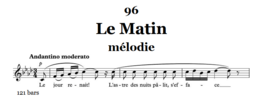
Every repertory has idiosyncrasies that make the adoption of a standard template ill-advised. Hugh Macdonald's Bizet Catalogue shows one of Bizet's idiosyncrasies through a listing of the composer's transcriptions of works by others (Gounod, Mozart, Saint-Saëns, et al.). The primary listing of works gives folio-by-folio detail of manuscripts for longer works with texts of underlying verses and notes on their authors, citations of self-borrowings, and much else.
Benjamin Britten Thematic Catalogue
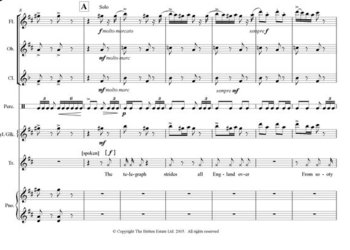
Website: http://www.brittenproject.org
The Britten Thematic Catalogue, an online only project based at the Britten-Pears Foundation, provides multiple access points for searching. Britten's career was extremely wide-ranging. His arrangements of music by Henry Purcell (54 titles) and of British folksongs (74 titles) filled much of his time in the 1940s and early '50s. The full gamut stretches from chamber music (134 items) mainly from the 1920s to his stage work Death in Venice (1973). Each work contains a detailed index with a graphical display and sound files.
Chambonnières: A Thematic Catalogue
Website: http://sscm-jscm.org/instrumenta/instrumenta-volumes/instrumenta-volume-1
Bruce Gustavson's Chambonnières: A Thematic Catalogue. The Complete Works of Jacques Champion de Chambonnières (1601/02–1672) appears as Vol. 1 in the Instrumenta series of the Society for Seventeenth-Century Music. The series is digital only and is dedicated to voluminous music bibliographies.
Frescobaldi Thematic Catalogue Online
Website: http://frescobaldi.music.duke.edu
This database, developed by Alexander Silbiger at Duke University, has a multi-faceted search interface. It is cross-linked to RISM IDs and has detailed source listings. (Content tends to vary slightly by source.) The general time-frame indicator gives a sense of the long tradition of recopying that followed the composer's works. Links to printed commentaries and modern editions are provided. Currently 906 works are included.
GWV - Graupner-Werke-Verzeichnis (Thematic Catalogue of the Works of Christoph Graupner)
Website: http://www.graupner-digital.org/gwv.php
This online catalog of works for Christoph Graupner (1683-1760) contains links to his digitized manuscripts at the Technische Universität in Darmstadt. After studies at the Thomas Schule, Leipzig, and a stint as cembalist of the Hamburg Opera orchestra (from 1705), Graupner was called to the service of Ernst Ludwig of Hesse-Darmstadt (1709). He remained there for the rest of his life. His numerous works (1,418 church cantatas, 24 secular cantatas, 113 symphonies, 44 solo concertos, 80 suites, miscellaneous chamber music, and eight operas) are largely preserved in the Darmstadt University and (Hessian) State Library. Links on the left lead to manuscript reproductions, those on the right to commercial recordings and editions. Florian Hayerick directs the project.
J.P.E. Hartmann Catalogue (Thematic-Bibliographic Catalogue of His Works)
Website: http://www.kb.dk/dcm/hartw/navigation.xq
Among his 590 compositions, Johan Peter Emilius Hartmann (1805-1900) demonstrated his mastery of all current genres (stage, choral, instrumental, organ, and vocal music) during his long lifetime. Although of German descent, he spent almost all of his life in Copenhagen. Louis Spohr and Christoph Ernst Friedrich Weyse were important influences. He was also acquainted with Fryderyk Chopin, Gioachino Rossini, and Luigi Cherubini. This presentation color-codes each genre so that as users pass down the list of his works, they can easily recognize changes of boundary without being trapped by them. Within each genre, listings are organized alphabetically.
Franz Liszt: Digital Liszt Sources and Works Catalog)
Website: https://www.uni-heidelberg.de/en/newsroom/franz-liszt-digital
This recently launched project to catalogue all Lizst (1811-1885), based at the University of Heidelberg, emphasizes resources in Dresden and Weimar, where the composer spent some periods of his life. Christiane Wiesenfeldt is the director. Liszt's father ws a musician in the Esterhazy court in Sopron (Hungary today, Austria then). He is remembered today for his many innovations in musical form and harmony and for his many friendship with composers and writers. Some early fruits of the project have been made available by RISM. See Lizst resources listed by RISM.
Catalogue of Carl Nielsen's Works

Website: http://www.kb.dk/dcm/cnw/navigation.xq
The Danish National Library has prepared this online catalogue of 414 pieces, including operas, symphonies, and concertos plus vocal, choral, and chamber pieces. Each entry includes musical incipits, lists of sources and sketches, citations for textual sources, and lists of performances.
In association with the Nielsen Catalogue, implemented by Axel Teich Geertinger, an editing tool for metadata used in similar projects has been developed by Sigfrid Lundberg and can be downloaded from GitHub. Based on MEI, the foundation of MerMEId was laid by Kristine Richts and Maya Hartwig. Further details about MerMEId and a sample implementation can be found at this site.
Johann Adolph Scheibe: A Catalogue of his Works
Website: http://www.kb.dk/dcm/schw/navigation.xq
The son of an organ-builder, Johann Adolph Scheibe (1708-1776) studied law in Leipzig prior to pursuing a career in music. During a short stint in Hamburg, where he met Johann Mattheson, Schiebe began his periodical Der Critische Musicus (1737-1740). It lapsed after his move (1739) to Copenhagen, where he served as court Kapellmeister first under the pious Christian VI, then under the more liberal Frederick V. Apart from his criticism, theoretical works, satires, and letters, Scheibe authored 80 instrumental pieces, a few dozen secular vocal works, a handful of stage pieces, songs, poems, text translations, and a few satires. This catalogue of holdings, produced by the Danish National Library, includes digitized images of them.
Printed music resources
Prices of Music at Breitkopf & Härtel
Website: https://dstrykowski.shinyapps.io/pricesofmusic
In a great wave of music publishing in the nineteenth century, Breitkopf & Härtel of Leipzig was a leader. This website offers titles of sheet-music and their prices as listed in the monthly supplement called the Intelligenz-blatt zu Algemeine musikalische Zeitung over the period 1798 to 1838. This data set contains 6,405 advertisements for the music of approximately nine hundred composers and arrangers. Details gathered from the publication lists include the issue number, date of advertisement, name of composer or arranger, title of publication (often with key and instrumentation), and price as quoted in Saxon thalers and groschen.
Verzeichnis deutscher Musikfrühdrucke / Catalogue of early German printed music
Website: https://vdm-maps.zgis.at
When it comes to offering multiple views of data (in this collected for cataloguing), the Verzeichnis/Catalogue of Early Printed music in German-speaking lands (1470-1550) offers an apt demonstration. Eight views, each focusing on a different aspect of the material, are presented. The charts are interactive, and by clicking on them further detail arrives in pop-ups.
Ethnomusicology
Images, sound files, and videos on the internet offer great scope for ethnomusicological study, but much of the material is limited to poorly documented materials with arbitrary labels. Only selected sites can be included here.
OSMIKON
This search engine (in German) for literature on world music concentrates on music from South, Central, and Eastern Europe but covers myriad other places (Bolivia, Bulgaria, Vietnam, Bollywood dance) and theoretical perspectives on a broad range of topics. It forms part of the Virtuelle Fachbibliothek Osteuropa (Virtual Library of Eastern Europe). Searches for the word "Musik" serve as an orientation.
Philippine Indigenous Instrument Sounds (Katunog)
Website: https://katunog.asti.dost.gov.ph
This database of sounds, hosted by the Department of Science and Technology of the Advanced Science and Technology Institute (DOST-ASTI), University of the Philippines (UP), provides photographs, descriptions of indigenous instruments and how they are played, together with sound samples synchronized with animated illustrations. The site provides substantial amounts of metadata and selected videos of performances.
UNC Middle Eastern Music
Website: http://guides.lib.unc.edu/c.php?g=9254&p=45825
The University of North Carolina offers top-down collections of selected repertories from Egyptian, Turkish, Iraqi, and classical Persian music. Each site varies from the others. Explanatory material concerning composers, instruments, styles, and cultural emphases are general to most. The Farabi site also discusses theoretical concepts in Persian classical music. The Turkish one contains many sound examples.
Tunisian Recordings (CMAM)
Website: http://phonotheque.cmam.tn/archives/full_access_items
The phonothèque of the Centre des Musiques Arabes et Méditérranéennes (CMAM) offers access to almost 2,500 recordings of Tunisian music in its Ennejma Ezzahra website. Dates of recordings, which are predominately from recent decades, are given in an accompanying database. Titles are given in Arabic script and in transliteration. The recording entity and the sponsor are also indicated.
Resources for Chronology
Music Bibliography in the German Democratic Republic
Website: http://digital.slub-dresden.de/werkansicht/dlf/2258/1/cache.off
Music Bibliography in the German Democratic Republic (Deutsche Demokratische Republik or DDR, 1949–1990) is an idiosyncratic subject but one which those engaged in music history of the later twentieth century may find compelling. The illustration accompanying this entry shows the full title of a typescript catalogue of new works (scores, writings on music theory, books, articles, and much miscellany) for the year 1975. This item can be found here.
Hofmeister XIX
Website: http://www.hofmeister.rhul.ac.uk/2008/index.html
Database of 330,000 records from the Hofmeister Monatsberichte, 1829-1900, listing music publications of the period. Compiled by Friedrich Hofmeister and published in Leipzig by Breitkopf & Härtel. Well indexed for quick searches.
Libretto Portals
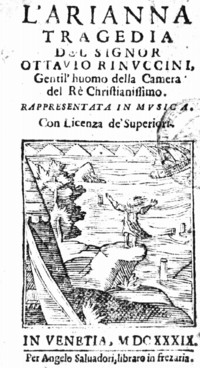
Corago Project
Website: http://corago.unibo.it
The Corago website contains multiple indices related to the history of opera. The libretto search engine is a comprehensive tool for locating information about librettos in catalogued collections. Hyperlinks to digitized librettos (see below) are inserted as appropriate. A database of productions continues up to present times. Clicking in the top row of the results orders results according to user preferences.
Corago is a collaborative project headed by Angelo Pompilio. Institutional cooperation is provided by almost two dozen institutions in Northern Italy. The two largest libretto collections included are the Corniati-Algarotti (12,000 librettos) listed separately below and that of the Museo Internazionale e Biblioteca della Musica (11,000 librettos) in Bologna. Corago is the central search-engine for digitized libretti in the Bologna collection, but other pertinent materials can be found here.
Corniani-Algarotti Libretto Collection
Website: http://www.braidense.it/cataloghi/catalogo_rd.php
Although the search form shows only four fields, the name field (nome) will accept almost any proper noun (surname of composer, librettist, scenographer, city, theater, etc.). Most sources are digitized and downloadable. This collection holds 9,000 libretti (in Italian) from the sixteenth through the nineteenth centuries. Some were published and used outside Italy. Most texts were for operas, but oratorio, cantata, and serenata texts can also be found.
Russian Opera Libretti
The Russian Opera Libretti collection at Princeton University contains scripts for operas published between 1815 and 1916. Most works are well known. Works set to music by Donisetti, Meyerbeer, Mussorgsky, Scriabin, Tchaikovsky, Verdi, and Wagner are included.
Albert Schatz Collection (Library of Congress)
Website: https://www.loc.gov/collections/albert-schatz/about-this-collection
The Rostock music dealer Albert Schatz (1839-1910) intended to write a history of opera based on primary sources. Although this goal was not realized, the donation of his sources and notes to the Library of Congress more than a century ago (1908) has long been a valuable offline resource. Scanned copies of more than 12,000 libretti, primarily representing Italian, French, and German prints of the seventeenth through nineteenth centuries, have now been placed online. The printed catalog of the collection by Oscar Sonneck is well known. Various filters can be found here.
VifaMusik Libretto Portal
Website: http://libretti.digitale-sammlungen.de/de/fs1/start/static.html
The new (2014) VifaMusik Libretto Portal searches across component collections held in the Bavarian State Library (5600 items), the Frankfurt University Library, and the Library of the German Institute in Rome (1500 titles). One can search by composer, librettist, and so forth. Since the term libretto referred to any small book, texts for oratorios, cantatas, serenatas, ballets, and so forth occur in some of the constituent collections.
Index to Opera and Ballet Sources Online
Website: https://atom.lib.byu.edu/obps/
